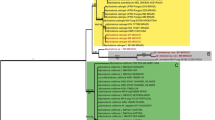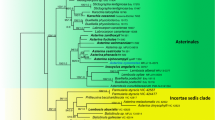Abstract
Four new species of Mariannaea were described in this paper, namely M. chlamydospora, M. cinerea, M. fusiformis, and M. lignicola. Mariannaea chlamydospora is characterized by its cream-colored, zonate colonies on PDA, smooth conidiophores, fusiform conidia, and abundant chlamydospores. Mariannaea cinerea forms grey colonies and ellipsoidal to subglobose conidia. Mariannaea fusiformis forms purple colonies and fusiform to subglobose conidia. Mariannaea lignicola has brown conidiophores and broad hyphae. The molecular phylogeny was inferred using ITS, LSU, and TUB-2 loci. The type species of Mariannaea (M. elegans) is epitypified. The variety M. elegans var. punicea is raised to species rank. Mariannaea clavispora is excluded from Mariannaea because of its cylindrical phialides, straight conidial chains and deviating phylogenetic affinity. Mariannaea nipponica did not fit well the generic concept of Mariannaea based on their morphological characters, and its generic placement remains uncertain. A key to the currently accepted 15 species of Mariannaea is provided.







Similar content being viewed by others
References
Benson DM, Parker KC, Munster M, Ivors K (2011) First report of stem dieback and leaf spot of Leucothoe caused by Cylindrocladium colhounii in North Carolina. Plant Health Prog. doi:10.1094/PHP-2011-0628-01-BR
Cabral A, Groenewald JZ, Rego C, Oliveira H, Crous PW (2012) Cylindrocarpon root rot: multi-gene analysis reveals novel species within the Ilyonectria radicicola species complex. Mycol Prog 11(3):655–688. doi:10.1007/s11557-011-0777-7
Cai L, Zhang KQ, McKenzie EHC, Hyde KD (2003) Freshwater fungi from bamboo and wood submerged in the Liput River in the Philippines. Fungal Divers 13:1–12
Cai L, Kurniawati E, Hyde KD (2010) Morphological and molecular characterization of Mariannaea aquaticola sp. nov. collected from freshwater habitats. Mycol Prog 9(3):337–343. doi:10.1007/s11557-009-0641-1
Chaverri P, Salgado C, Hirooka Y, Rossman AY, Samuels GJ (2011) Delimitation of Neonectria and Cylindrocarpon (Nectriaceae, Hypocreales, Ascomycota) and related genera with Cylindrocarpon-like anamorphs. Stud Mycol 68:57–78. doi:10.3114/sim.2011.68.03
Corda ACJ (1838) Icones fungorum hucusque cognitorum 2:1–43
Crous PW, Kang JC (2001) Phylogenetic confirmation of Calonectria spathulata and Cylindrocladium leucothoes based on morphology, and sequence data of the β-tubulin and ITS rRNA genes. Mycoscience 42(1):51–57. doi:10.1007/bf02463975
Crous PW, Groenewald JZ, Risède J-M, Simoneau P, Hywel-Jones NL (2004) Calonectria species and their Cylindrocladium anamorphs: species with sphaeropedunculate vesicles. Stud Mycol 50:415–430
Gams W (2017) An annotated checklist of epithets published in Verticillium and Acrostalagmus, some similar genera, and teleomorphs associated with verticillium-like anamorphs. Nova Hedwigia. doi:10.1127/nova_hedwigia/2016/0371
Gams W, Seifert K, Morgan-Jones GA (2009) New and validated hyphomycete taxa to resolve nomenclatural and taxonomic issues. Mycotaxon 110(1):89–108
Gräfenhan T, Schroers H-J, Nirenberg HI, Seifert KA (2011) An overview of the taxonomy, phylogeny and typification of some nectriaceous fungi classifed in Cosmospora, Acremonium, Fusarium, Stilbella and Volutella. Stud Mycol 68:79–113. doi:10.3114/sim.2011.68.04
Guo LD, Hyde KD, Liew ECY (2000) Identification of endophytic fungi from Livistona chinensis based on morphology and rDNA sequences. New Phytol 147(3):617–630. doi:10.1046/j.1469-8137.2000.00716.x
Hall TA (1999) BioEdit: a user-friendly biological sequence alignment editor and analysis program for Windows 95/98/NT. Nucleic Acids Symp Ser 41:95–98
Halleen F, Schroers H-J, Groenewald JZ, Crous PW (2004) Novel species of Cylindrocarpon (Neonectria) and Campylocarpon gen. nov. associated with black foot disease of grapevines (Vitis spp.). Stud Mycol 50:431–455
Halleen F, Schroers H-J, Groenewald JZ, Rego C, Oliveira H, Crous PW (2006) Neonectria liriodendri sp. nov., the main causal agent of black foot disease of grapevines. Stud Mycol 55:227–234. doi:10.3114/sim.55.1.227
Herrera CS, Rossman AY, Samuels GJ, Chaverri P (2013) Pseudocosmospora, a new genus to accommodate Cosmospora vilior and related species. Mycologia 105(5):1287–1305
Hirooka Y, Rossman AY, Chaverri P (2011) A morphological and phylogenetic revision of the Nectria cinnabarina species complex. Stud Mycol 68:35–56. doi:10.3114/sim.2011.68.02
Hirooka Y, Rossman AY, Samuels GJ, Lechat C, Chaverri P (2012) A monograph of Allantonectria, Nectria, and Pleonectria (Nectriaceae, Hypocreales, Ascomycota) and their pycnidial, sporodochial, and synnematous anamorphs. Stud Mycol 71:1–210. doi:10.3114/sim0001
Hu DM, Cai L, Chen H, Bahkali AH, Hyde KD (2010) Fungal diversity on submerged wood in a tropical stream and an artificial lake. Biodivers Conserv 19:3799–3808. doi:10.1007/s10531-010-9927-5
Hu DM, Cai L, Hyde KD (2012a) Three new ascomycetes from freshwater in China. Mycologia 104(6):1478–1489. doi:10.3852/11-430
Hu DM, Chen H, Cai L, Bahkali AH, Hyde KD (2012b) Aquapeziza: a new genus from freshwater, and its morphological and phylogenetic relationships to Pezizaceae. Mycologia 104(2):540–546. doi:10.3852/11-123
Lombard L, Crous PW, Wingfield BD, Wingfield MJ (2010) Phylogeny and systematics of the genus Calonectria. Stud Mycol 66:31–69. doi:10.3114/sim.2010.66.03
Lombard L, van der Merwe NA, Groenewald JZ, Crous PW (2015) Generic concepts in Nectriaceae. Stud Mycol 80:189–245. doi:10.1016/j.simyco.2014.12.002
Luangsa-ard JJ, Hywel-Jones NL, Samson RA (2004) The polyphyletic nature of Paecilomyces sensu lato based on 18S-generated rDNA phylogeny. Mycologia 96(4):773–780
Luangsa-ard JJ, Hywel-Jones NL, Manoch L, Samson RA (2005) On the relationships of Paecilomyces sect. Isarioidea species. Mycol Res 109(05):581–589. doi:10.1017/S0953756205002741
Luo J, Zhuang WY (2010) Chaetopsinectria (Nectriaceae, Hypocreales), a new genus with Chaetopsina anamorphs. Mycologia 102(4):976–984. doi:10.3852/09-263
Matsushima T (1975) Icones Microfungorum a Matsushima lectorum. Matsushima, Kobe, Japan
Matsushima T (1989) Matsushima Mycological Memoirs No. 6. Matsushima Fungus Collect. Kobe, Japan
Matsushima T (1995) Matsushima Mycological Memoirs No. 8. Matsushima Fungus Collect, Kobe, Japan
Nonaka K, Kaneta T, Ōmura S, Masuma R (2015) Mariannaea macrochlamydospora, a new hyphomycete (Nectriaceae) from soil in the Bonin Islands, Japan. Mycoscience 56(1):29–33. doi:10.1016/j.myc.2014.02.001
O’Donnell K, Cigelnik E (1997) Two divergent intragenomic rDNA ITS2 types within a monophyletic lineage of the fungus Fusarium are nonorthologous. Mol Phylogenet Evol 7(1):103–116
Posada D (2008) jModelTest: phylogenetic model averaging. Mol Biol Evol 25(7):1253–1256
Réblová M, Gams W, Seifert KA (2011) Monilochaetes and allied genera of the Glomerellales, and a reconsideration of families in the Microascales. Stud Mycol 68:163–191. doi:10.3114/sim.2011.68.07
Risède JM, Simoneau P (2001) Typing Cylindrocladium species by analysis of ribosomal DNA spacers polymorphism: application to field isolates from the banana rhizosphere. Mycologia 93(3):494–504. doi:10.2307/3761735
Ronquist F, Teslenko M, van der Mark P, Ayres DL, Darling A, Höhna S, Larget B, Liu L, Suchard MA, Huelsenbeck JP (2012) MrBayes 3.2: efficient Bayesian phylogenetic inference and model choice across a large model space. Syst Biol 61(3):539–542
Samson RA (1974) Paecilomyces and some allied hyphomycetes. Stud Mycol 6:1–119
Samson RA, Bigg WL (1988) A new species of Mariannaea from California. Mycologia 80(1):131–134
Samuels GJ (1985) Four new species of Nectria and their Chaetopsina anamorphs. Mycotaxon 22:13–32
Samuels GJ (1989) Nectria and Penicillifer. Mycologia 81(3):347–355
Samuels GJ, Seifert KA (1991) Two new species of Nectria with Stilbella and Mariannaea anamorphs. Sydowia 43:249–263
Schroers HJ, Geldenhuis MM, Wingfield MJ, Schoeman MH, Yen YF, Shen WC, Wingfield BD (2005) Classification of the guava wilt fungus Myxosporium psidii, the palm pathogen Gliocladium vermoesenii and the persimmon wilt fungus Acremonium diospyri in Nalanthamala. Mycologia 97(2):375–395
Seifert KA, Morgan-Jones G, Gams W, Kendrick B (2011) The genera of hyphomycetes. CBS-KNAW Fungal Biodiversity Centre Utrecht, Utrecht, Netherlands
Stamatakis A, Alachiotis N (2010) Time and memory efficient likelihood-based tree searches on phylogenomic alignments with missing data. Bioinformatics 26(12):i132–i139
Thompson JD, Gibson TJ, Plewniak F, Jeanmougin F, Higgins DG (1997) The Clustal_X windows interface: flexible strategies for multiple sequence alignment aided by quality analysis tools. Nucleic Acids Res 25(24):4876–4882
Tokumasu S, Aoki T, Oberwinkler F (1994) Fungal succession on pine needles in Germany. Mycoscience 35(1):29–37
Vilgalys R, Hester M (1990) Rapid genetic identification and mapping of enzymatically amplified ribosomal DNA from several Cryptococcus species. J Bacteriol 172(8):4238–4246
White TJ, Bruns T, Lee S, Taylor JW (1990) Amplification and direct sequencing of fungal ribosomal RNA genes for phylogenetics. In: Innis MA, Gelfand DH, Sninsky JJ, White YJ (eds) PCR Protocols: A Guide to Methods and Application. Academic Press, San Diego, pp 315–322
Zare R, Gams W, Starink-Willemse M, Summerbell RC (2007) Gibellulopsis, a suitable genus for Verticillium nigrescens, and Musicillium, a new genus for V. theobromae. Nova Hedwigia 85:463–489
Zeng ZQ, Zhuang WY (2014) A new holomorphic species of Mariannaea and epitypification of M. samuelsii. Mycol Prog 13(4):967–973. doi:10.1007/s11557-014-0980-4
Zeng ZQ, Zhuang WY (2016) A new species of Cosmospora and the first record of sexual state of C. lavitskiae. Mycol Prog 15(6):1–7. doi:10.1007/s11557-016-1201-0
Zhaxybayeva O, Gogarten JP (2002) Bootstrap, Bayesian probability and maximum likelihood mapping: exploring new tools for comparative genome analyses. BMC Genomics 3(1):4. doi:10.1186/1471-2164-3-4
Acknowledgments
Funds for research were provided by NSFC 31093440 & 31460009. The authors thank Miss Fang Liu for her help on lab work. DMH and LC are very grateful to Prof. Eric H.C. Mckenzie who taught them the first Hyphomycetes course in their science careers. M. Wang acknowledges CAS 153211KYSB20160029 for supporting her postgraduate studentship.
Author information
Authors and Affiliations
Corresponding author
Additional information
Section Editor: Roland Kirschner and Pedro W. Crous
This article is part of the “Special Issue in honour of the 70th birthday of Dr. Eric McKenzie”.
Rights and permissions
About this article
Cite this article
Hu, DM., Wang, M. & Cai, L. Phylogenetic assessment and taxonomic revision of Mariannaea . Mycol Progress 16, 271–283 (2017). https://doi.org/10.1007/s11557-016-1252-2
Received:
Revised:
Accepted:
Published:
Issue Date:
DOI: https://doi.org/10.1007/s11557-016-1252-2




